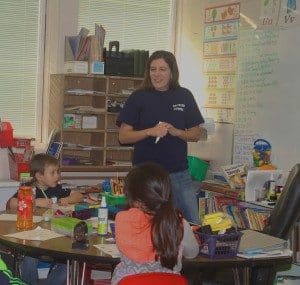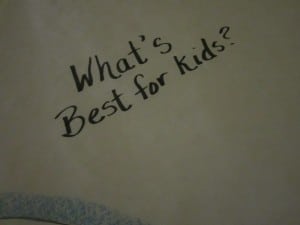Chugach Teachers Talk about Teaching
CompetencyWorks Blog

This is the third post in the Chugach School District series. Read the first and second posts here.
Chugach School District is a teacher’s district. Bob Crumley, Superintendent, started as a teacher in Whittier Community School (WCS). (There is a story about his coming face to face with a bear that had wandered into the school in search of sausage.) Debbie Treece, Director of Special Education, signed up to teach at Whittier before realizing that the only way to get there at the time was to travel through a tunnel sitting in absolute darkness…and this after driving one’s car onto the back of a railway flat. Doug Penn, District Principal, has worked in the communities of Chenega Bay and Whittier.
It’s also a learner’s district, because everyone at CSD is willing to learn in order to do better by their students and their families.
Not every person is cut out to teach at CSD. You’ve got to want a bit of adventure. You’ve got to have a love for the incredible mountain-meets-sea landscape. You’ve got to be willing to live in small communities that have limited access. And you’ve got to love kids.
There were incredibly rich conversations with teachers throughout my three days at CSD. Here are a few of the highlights:
On Being a Generalist or Not-Yet-Specialists
Not exactly one-room schools houses, but close, the Chugach School District schools are PreK-12 with just a handful of teachers. Teachers start out as generalists, perhaps with a preference or skills in one discipline or another. Every teacher has a story to tell about how they were weak in one area or another when they started, and how they’ve been slowly building up their skills ever since. In the meantime, they know they can depend on each other for skill-building support, as well as for assistance working with individual students who need extra help. Ashley Reeves a new teacher at Tatitlek Community School (TCS) remarked, “In your first year, you have to be ready to ask for help and cling to anyone who is willing.” Nichole Palmer confirmed this. “Your team is key. We capitalize on all of our strengths.”
In a school with student empowerment at its core, being a generalist isn’t a weakness. Jed Palmer, Head Teacher at TCS, explained, “School culture is important if you are going to have a team of generalists. In our schools, teachers are learning along with the students. We do not position ourselves as experts. In fact, when we don’t know something, it creates the opportunity for us to role model continuous learning by saying ‘let’s go find out.’”
Penn emphasized, “Once we became performance-based, the teacher retention rates shot up. Performance-based approaches encourage collaboration. It helped us to create the conditions to pursue professional development. We support our staff as they pursue Master’s degrees in special education, become highly qualified in additional areas, and get administrative certificates.” For example, CSD has been expanding the number of teachers who are highly qualified in math.
The teacher/performance evaluation process (referred to as PEP) is designed to reflect the fact that teaching staff are generalists. “Our teacher evaluation emphasizes the process of teaching, not content,” Penn said. Yet, the investment in professional development helps to rapidly expand the skills of teachers. Jed Palmer noted, “I wouldn’t advise trying to be expert in everything. Start in one area and get comfortable. I was comfortable with social studies when I started and passionate about math. So I worked on math for two years. You aren’t going to be a rock star in all about them. After ten years at CSD, I am highly qualified in all subjects.”
The size of the district means that when hiring, Crumley and Penn think about the whole organization. They ask themselves how they can strengthen the district’s capacity as well as individual schools. Penn emphasized, “We don’t hire teachers, we hire members of a team. We don’t want people to compartmentalize. We want them to work with their colleagues to develop interdisciplinary projects. We want people who value being part of a team.”
On Respect, Autonomy, and Creativity
Janet Reed, a homeschool teacher, described teaching when there is no mandated curriculum. “We have a lot of responsibility on our shoulders, and we rise to that occasion. We are given enormous amounts of professional respect. And we appreciate it. If you are treated as a professional, then it encourages you to act as a professional.”
Penn noted, “You can’t empower people by just saying it. We have to create the conditions for our teachers to succeed. We foster a culture where teachers can find success through networks and structures, and where they have the freedom to work together to find solutions and make decisions. We also have systems in place. You need both a strong culture of learning and the systems to support it.”
“The opportunity for creativity can be intimidating,” Jed Palmer added. “We are open about it – it can be scary when you know you need to do better, but it’s not exactly clear how. We talk about it openly with each other. It may feel like a teacher is walking on a tightwire without a net, but our job is to not let each other fall off. It can be really rewarding.”
Of course, creativity means taking risks. Jed Palmer continued, “I’ve developed really beautiful units balancing instructional strategies. And then they bomb because the students don’t have any interest. Then you have to be able to adapt and figure out what is going to work. It’s best if you can have student input in designing units. The more collaboration, the better.”

Fellow teacher at Tatitlek, Nichole Palmer, continued, “It was hard when I left here and went back to a traditional school. I didn’t enjoy it at all. It was so rigid without any opportunity to be creative. Worst of all, decisions didn’t feel like they were being made in the best interest of the kids.
Erika Thompson , a teacher at Whittier, was equally in support of the system. “This is a dream job for someone right out of education school. When I first got here, I just wanted a textbook to follow. But everyone was willing to share their lessons and units. I was definitely stretched. I learned more than I did the entire time in school.”
Shannon O’Brien, a homeschool teacher who has also taught in Chenega Bay and Whittier Community Schools, explained, “The homeschool program is even more individualized and flexible than the performance-based classrooms tend to be because parents are the teachers and have chosen resources that address their child’s individual needs. What I’ve learned is that when a teacher is first exposed to the standards-based classroom, we bring assumptions about teaching, standards, and assessments. It was more black and white than it needs to be. With the performance-based system, you can say yes more. You can be really creative about what learning experiences look like. I’m constantly asking ‘What about… Could the kids do it this way? What if we do… Could they meet the standards?’ Learning happens in so many way. There isn’t one way to do it. There isn’t one script that we have to follow.”
As Penn pointed out, it’s not creativity for the sake of creativity. “Think about it as the three sides of a triangle surrounded by an enormous circle of students’ ever-changing interests and passions. Side one is where we always consider the standards that define what students need to know (but we don’t always start there, as it isn’t a natural place for how we learn). Side two is how we consider the assessment in our design process, asking ourselves, ‘How will I know if the students really learned it?’ The third part of the design triangle is instruction that identifies how the students are going to learn it. This can be co-designed with students. This is where a lot of creativity comes into play. It’s often an iterative process to get it fully aligned.”
The underlying respect to allow this level of autonomy and creativity is based in the esteem between teachers, students, family, and the community. “Students are bringing their own unique experiences and perspectives,” Penn said. “The teacher’s job is to get to know the students and their families. Teachers are responsible to the students, the families, and the community to create an instructional environment where kids can succeed.”
Investing in a Strong Team of Teachers
 Crumley’s commitment to creating a strong team of teachers dominated much of our conversation. “Continuity of leadership across the district is critical for sustaining our work in such a small district.” There are several structures that have been created to systematically support teachers. They all reinforce a culture of collaboration, learning, and leadership.
Crumley’s commitment to creating a strong team of teachers dominated much of our conversation. “Continuity of leadership across the district is critical for sustaining our work in such a small district.” There are several structures that have been created to systematically support teachers. They all reinforce a culture of collaboration, learning, and leadership.
As Missy DeRivera, a homeschool teacher, explained, “The leadership question is always central to our work. Is this best for kids? That is at the core of our entire district. We identify what is best for kids and then we figure out how to make it happen. Bob [Crumley] will do whatever is best for our kids. We all will.”
- Independent Teachers Union: In 1996, the teachers at CSD created their own teachers union, the Prince William Sound Teachers’ Association. The teachers were frustrated with the national union’s lack of support, high union dues, and political agendas, so they decided to represent themselves in order to better support their efforts in reinventing the education system.
- Investment in Learning and Leadership: Staff described that they turn to each other to support their learning and mentor each other, even across the schools. The districts offers up to thirty days of training annually, and teachers are encouraged to expand their skills based on their individual learning plans. In addition, leadership development is embedded into the expectations and supports, such as Leadership PIER (Plan, Implement, Evaluate, Refine) plans.
- Performance Evaluation Process (PEP): The staff development and evaluation process is remarkably similar to how students are assessed. It’s all about learning. It’s based on standards wherein staff provide evidence of their learning. All staff are expected to have at least one PIER plan (based on their focus areas and values) at all times to guide their learning. There are specific standards in the evaluation tool to encourage staff to share leadership and ownership. As part of the process, they provide documentation regarding their leadership efforts. The PEP has several components, including self-evaluation; comments and observations from students, parents, coworkers, and community members; individual meetings with the administrative supervisor; development of individual goals and action plan (PIER plan); collection and presentation of artifacts to support self-evaluation; and assistance in meeting district goals.
- Performance Pay: Every member of CSD receives an annual composite score on the PEP rubric, based on a seven-point scale. Crumley explained, “This score is significant because it is the foundation of the district performance pay system. In 1997, the CSD Team of teachers and administrators developed performance pay to be structured in alignment with our shared purpose and team spirit. So the individual PEP scores are averaged across the work group each year, and the average score is used as the multiplier for performance pay. We’ve balanced individual improvement with incentives to support each other. While the score and the performance pay are significant, even more significant is the process of holding deep reflection-based discussions about our work; what is going well and what are our individual and organizational opportunities for improvement.”
Jed Palmer concluded our discussion with a powerful statement. “Sure, we could make it easier for teachers, but then our students don’t succeed. The other option is to admit that teaching is a complex system, invest in the systems, nurture the culture to support professional teachers…and have the kids actually learn. It’s obvious which one is the better choice.”